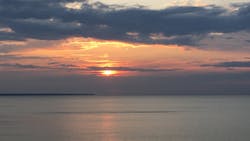I’m so lucky to live about a 10-minute walk from Lake Erie. Going to the park to watch the sun set over the lake is one of my favorite things to do in the summer. In fact, I realize that water features prominently in many other activities I enjoy: picnics, barbecues and dining al fresco; lounging on inner tubes; napping on the beach; and cruising in a boat.
In elementary school, I learned that the Great Lakes are among the largest bodies of fresh water on Earth. It’s a treasure in our own backyards, but often we don’t treat it as such.
Fresh, drinkable water is an increasingly scarce resource despite the melting of the polar ice caps and rising sea levels. Climate change and a growing global population are only going to make it worse. That is, unless we do something about it.
Water shortages aren’t just a hypothetical problem. They’re already here.
In 2018, Cape Town, South Africa, became the first major city in the world to broach Day Zero: when water supplies get so low that the water taps would be turned off.
And in the U.S., the most populous state in the nation, California, recorded the 2020-2021 season as the second driest year in The Golden State’s history. According to the National Integrated Drought Information System, about 57% of the lower 48 states were in a drought April 6-12, 2022, the most recent data available as of publication.
Meanwhile, Lake Erie has endured a different kind of threat: negligence and pollution. In the 1960s, the lake that touches parts of Canada, Michigan, Ohio, Pennsylvania and New York was declared a dead lake. Left largely unregulated—and unprotected—Lake Erie was polluted from factories, agricultural runoff, waste from city sewers and waterways that fed into the lake, e.g., the Cuyahoga River, which caught fire multiple times.
Those fires earned Cleveland the nickname “The Mistake on the Lake,” but those fires also prompted a flurry of action, including passage of the Clean Water Act. Lake Erie’s water dramatically improved, but it has once again found itself in metaphorical hot water.
Since the late 1990s, Lake Erie has experienced toxic algae blooms, a result of agricultural runoff, that turn its waters a bright blue-green. In August 2014, those blooms caused the city of Toledo, Ohio, to essentially shut down. About 400,000 people were told they couldn’t use the water from their faucet to cook, drink or brush their teeth. Boiling the water didn’t help, so many residents drove across state lines to find stores that still had bottled water on the shelves.
Algal blooms levels continue to be closely monitored, and there has been an increase in funding and attention to further research and knowledge. Unfortunately, it seems to be another case of two steps forward, one step back, as recent research has found more PFAS or toxic “forever chemicals” are making their way into Lake Erie. In 2021, raw data from a binational Great Lakes monitoring program found that rainwater contained PFAS in monitoring stations in Cleveland; Chicago; Sturgeon Point, N.Y.; and in Michigan’s Lower and Upper Peninsula.
It’s easy to watch the sun set over Lake Erie and despair. After all, there are often days where people are told not to swim in the lake, as the water is too polluted. For this Earth Day, I’m trying to stay optimistic that we can change our course and chart a new path.
The Great Lakes will receive $1 billion for cleanup and restoration as part of the $1.2 trillion Bipartisan Infrastructure Bill (Infrastructure Investment and Jobs Act). That’s in addition to the Great Lakes Restoration Initiative, which since 2010 has provided funding to different environmental infrastructure projects in the region.
Since the start of the COVID-19 pandemic, we’ve seen what good things can happen when we support Mother Nature, or at least let her heal herself. In Venice, Italy, less pollution meant the water in its famed canals turned clear. In Thailand’s Maya Bay, restricting human access, swimming and boat pollution has resulted in more blacktip sharks sightings and even breeding. These are merely two examples of how Mother Nature, her creatures, her waters, her habitats and her ecosystems have a strong and enduring will to survive, reclaim themselves and restore homeostasis. We just need to support them.
It’s up to us—as individuals, organizations, institutions and governments—to help preserve Mother Nature. In doing so, we collectively ensure our safety and well-being, both for ourselves and future generations.
About the Author
Nicole Stempak
Nicole Stempak is managing editor of EHS Today and conference content manager of the Safety Leadership Conference.

